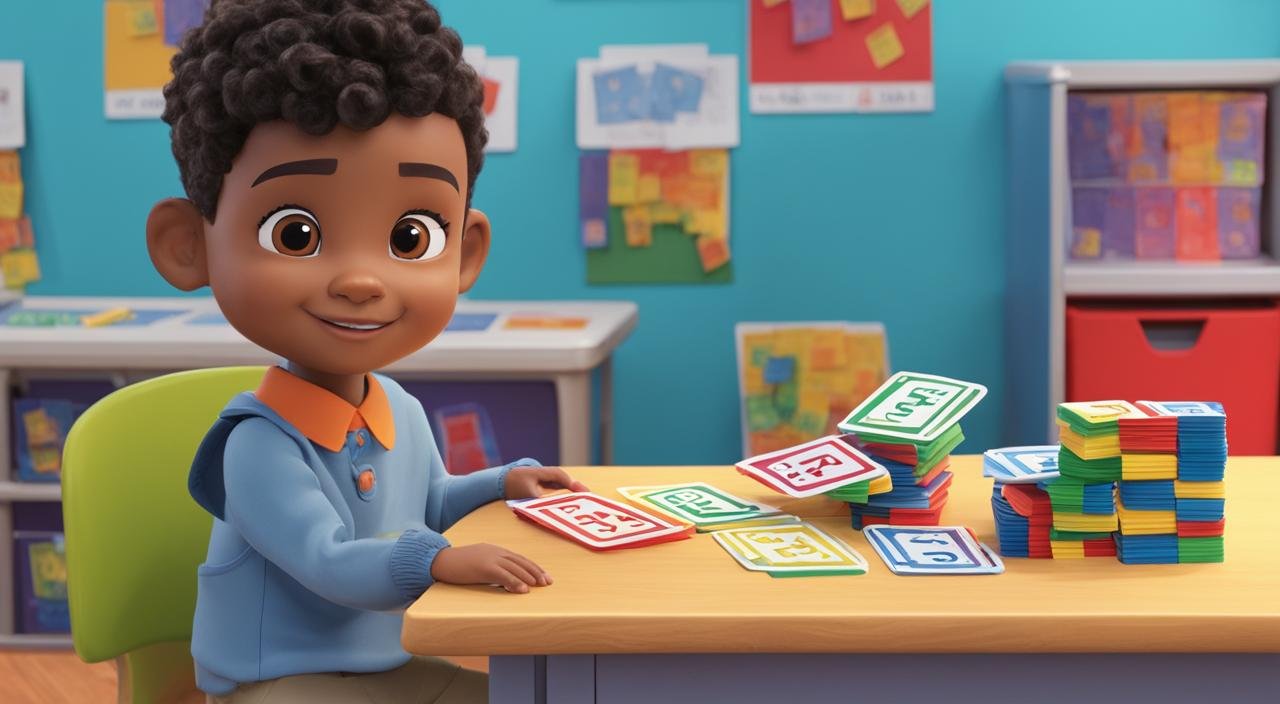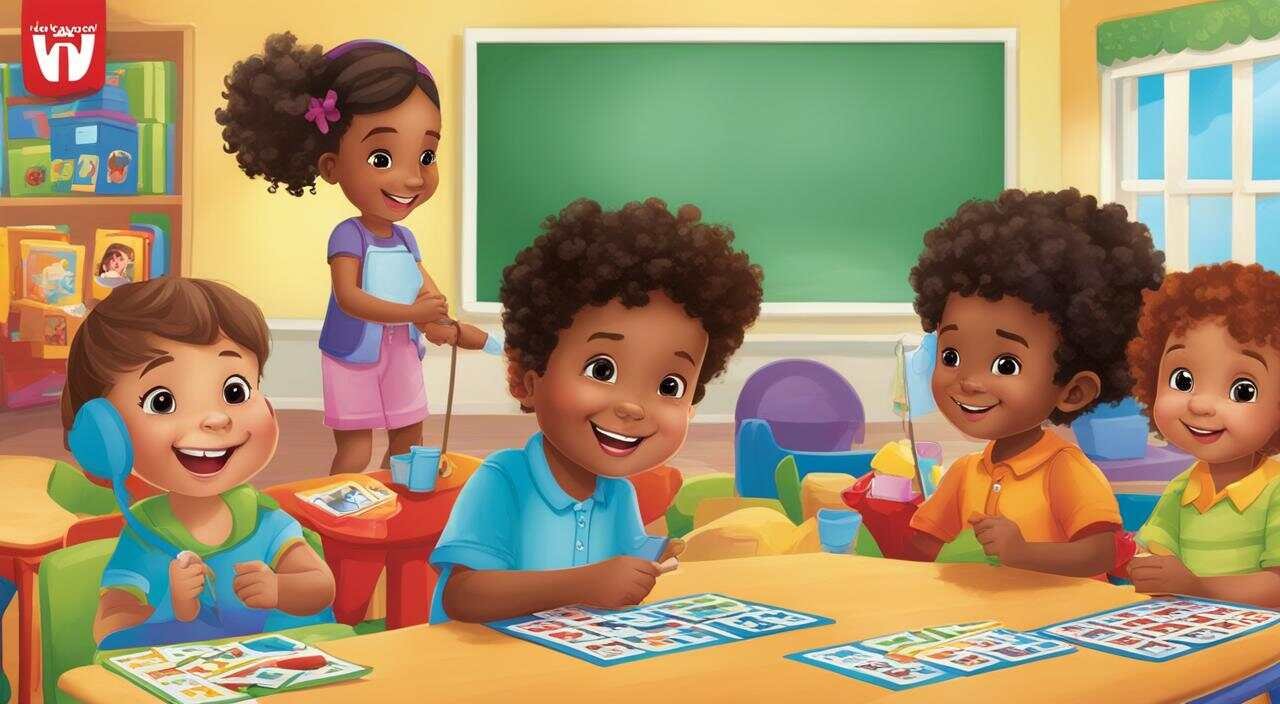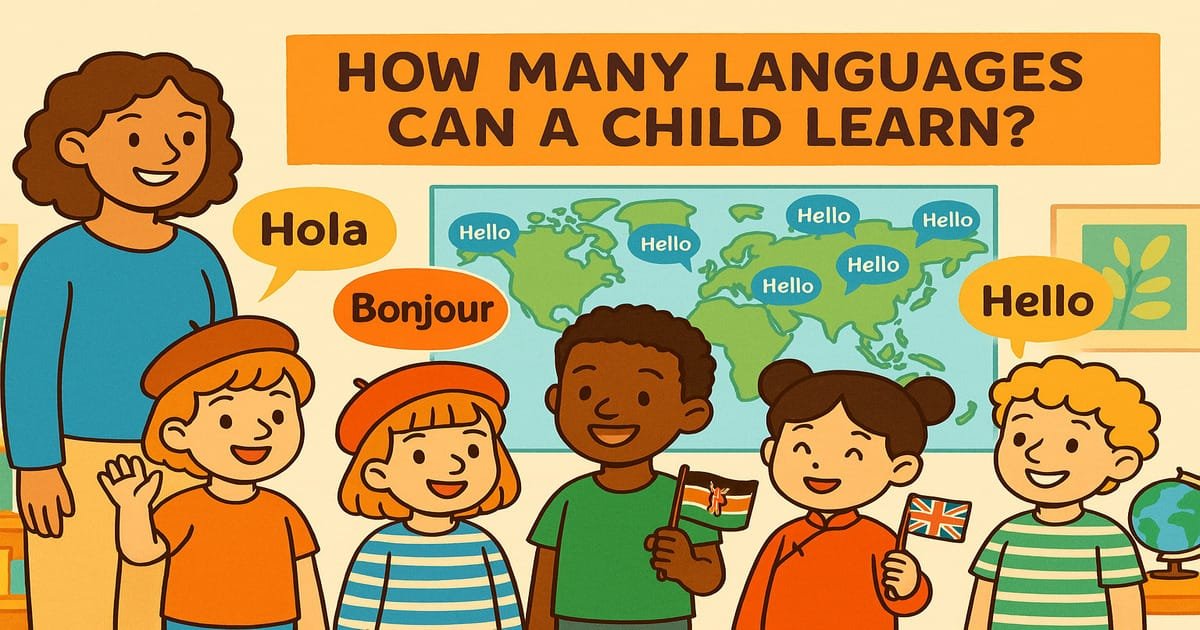Teaching sight words to preschoolers plays a vital role in their early literacy development. These words, commonly found in written language, are crucial for reading fluency and comprehension. But how do you make sight word learning engaging and effective for young children?
In this article, we will explore various strategies, activities, and games that can help you teach sight words to preschoolers while keeping it fun and interactive. From repetition and flashcards to multi-sensory activities and interactive read-alouds, we’ll provide practical tips that you can implement in your teaching approach.
Whether you’re a parent or an educator, this article will equip you with the necessary tools to support preschoolers in developing strong sight word recognition and enhancing their reading skills. So, let’s dive in and discover the exciting world of sight word teaching!
Key Takeaways:
- Teaching sight words is essential for early literacy development in preschoolers.
- Sight words are high-frequency words that frequently appear in written language.
- Engaging activities and games can make the learning of sight words fun and effective.
- Repetition, flashcards, sight word books, and word walls are effective teaching strategies.
- Exposing preschoolers to sight words early on in their daily lives is highly beneficial.
What Are Sight Words and Why Are They Important?
Sight words are common words that children are expected to recognize by sight without having to sound them out. These high-frequency words do not follow typical spelling rules and often appear in texts. Recognizing sight words is important for young readers as it improves their reading fluency and comprehension.
When children can quickly identify sight words, they can focus more on understanding the overall meaning of the text rather than getting stuck on individual words. Sight words are often used in repetitive phrases and sentences, making them essential for building reading fluency. By memorizing these words, children can read more smoothly and with greater confidence.
Moreover, sight words often represent important concepts in reading. For example, words like “the,” “and,” and “said” are frequently used in stories and informational texts. Recognizing these words helps children understand sentence structure, follow along with the plot, and grasp the main ideas in a text.
To reinforce the importance of sight words and engage young learners, here’s an interactive quote:
“By recognizing sight words, young readers unlock the door to reading fluently and understanding texts with greater ease.”
Take a look at this word cloud that illustrates the significance of sight words for preschoolers:
| Sight Word | Frequency | Example Sentence |
|---|---|---|
| the | 523 | The cat is on the mat. |
| and | 343 | I like ice cream and cake. |
| said | 287 | The teacher said, “Good job!” |
| is | 243 | He is playing with his toys. |
| the | 238 | The dog is brown. |
As shown in the table, some sight words like “the” and “and” are incredibly common, appearing hundreds of times in various texts. Imagine the confidence and reading fluency a child can develop by recognizing and accurately reading these words effortlessly.
Overall, sight words are foundational for young readers, providing them with the necessary tools and skills to become proficient and confident readers.
Strategies for Teaching Sight Words to Preschoolers
When it comes to teaching sight words to preschoolers, there are several effective strategies that can make learning a fun and engaging experience. By using these strategies, you can help your child develop strong sight word recognition, which is crucial for their early literacy development.
Repetition and Flashcards
Repetition is key when it comes to learning sight words. By repeatedly exposing your child to these words, they will become more familiar and easier to recognize. Flashcards are a great tool for reinforcing sight word recognition. Create flashcards with sight words and encourage your child to practice reading them daily. This consistent practice will help them retain the words in their long-term memory.
Sight Word Books and Word Walls
Sight word books and word walls provide visual reinforcement, making it easier for preschoolers to recognize and remember sight words. Sight word books are designed specifically to introduce and reinforce sight words through engaging stories and colorful illustrations. Word walls display sight words prominently in the classroom or at home, serving as a visual reference for children as they learn and practice reading these words.
Online Resources and Interactive Games
The digital age has brought about a wealth of resources and interactive games that can make learning sight words fun and engaging for preschoolers. There are various websites, apps, and educational programs that offer interactive activities and games to help children practice sight word recognition. These resources often incorporate visuals, audio, and interactive elements to make the learning experience more enjoyable and effective.
Start with High-Frequency Words
When teaching sight words, it is important to start with high-frequency words. These are words that appear most frequently in written language and are essential for building reading fluency. By focusing on these commonly used words, you are giving your child a solid foundation for their reading skills.
Use Multisensory Strategies
Children have different learning styles, and incorporating multisensory strategies can be highly effective in teaching sight words. For example, you can encourage your child to trace sight words in sand or use magnetic letters to build and spell the words. These hands-on activities engage multiple senses, making the learning experience more interactive and memorable.
Celebrating success is also crucial in teaching sight words. When your child recognizes and reads a sight word correctly, praise their effort and achievement. This positive reinforcement will motivate them to continue learning and practicing.
By implementing these strategies, you can create a nurturing environment for your preschooler to learn and master sight words. Remember to make learning fun and celebrate their progress along the way!
| Strategies | Description |
|---|---|
| Repetition and Flashcards | Repeatedly expose your child to sight words and use flashcards for practice. |
| Sight Word Books and Word Walls | Utilize sight word books and create word walls to visually reinforce sight word recognition. |
| Online Resources and Interactive Games | Make use of digital resources and interactive games to engage preschoolers in sight word learning. |
| Start with High-Frequency Words | Focus on teaching sight words that appear most frequently in written language. |
| Use Multisensory Strategies | Incorporate hands-on activities that engage multiple senses to enhance sight word learning. |
Exposing Preschoolers to Sight Words Early On
Introducing sight words to preschoolers at an early age is crucial for their reading development. By exposing children to sight words in daily life, we can help familiarize them with these important words and build a strong foundation for literacy.
One effective way to expose preschoolers to sight words is through regular reading sessions. Whether it’s reading storybooks, picture books, or even signs around the house, involving children in reading activities can create a natural environment for sight word exposure. Emphasize sight words while reading and encourage children to identify them in the text.
Additionally, pointing out sight words in the child’s immediate environment can make learning more engaging. Take a walk outside and have your child point out sight words on street signs, store names, or even food labels. By connecting sight words to real-life objects and experiences, children can better understand their relevance and importance.
“Exposing preschoolers to sight words in their daily life helps create a visual-textual relationship and enhances their understanding of these words.”
To provide a visual representation of how sight words can be incorporated into daily life, here is an example:
| Daily Life Scenario | Sight Word Exposure |
|---|---|
| Mealtime | Point out sight words on food packaging or recipe cards. |
| Playtime | Label toys or play area with sight word cards. |
| Outdoor Explorations | Identify sight words on street signs or at the park. |
| Bedtime Routine | Select bedtime stories with prominent sight words. |
By incorporating sight words into various aspects of their daily routine, preschoolers can develop a deeper understanding of these words and recognize them more easily in other contexts.
Continue reading to explore more strategies for teaching sight words to preschoolers and discover how interactive read-alouds can enhance their sight word recognition skills.
Interactive Read-Alouds and Sight Words
Reading aloud with children is a wonderful way to engage them in stories and help develop their language and literacy skills. However, adding an interactive element to read-alouds can also enhance their learning experience. One effective way to make read-alouds interactive is by pointing out sight words while reading.
Sight words are high-frequency words that children should recognize instantly. By emphasizing repetitive phrases that contain sight words during read-alouds, you can help children identify and remember these important words. Encourage them to join in and say the sight words aloud with you.
Using books with speech bubbles can be particularly helpful in pointing out sight words while reading. The speech bubbles draw attention to the words and make it easier for children to identify them. This visual cue can strengthen their recognition of sight words and their overall reading skills.
“The little girl skipped down the street.“
“Can you spot the sight word in this sentence? It appears several times. Let’s say it together: street.“
By actively involving children in the read-aloud process and highlighting sight words, you are providing them with a valuable learning opportunity. Not only does this enhance their sight word recognition, but it also improves their overall reading fluency and comprehension.
Multi-Sensory Activities for Teaching Sight Words
Engaging children in multi-sensory activities can be an effective way to help them retain sight words in their long-term memory. By incorporating different senses, such as touch and movement, learning becomes more interactive and enjoyable. Here are some multi-sensory activities that can enhance sight word recognition:
- Filling in Missing Letters: Create worksheets or flashcards with sight words missing a letter or two. Encourage children to fill in the missing letters using pipe cleaners or tracing them with their fingers.
- Rearranging Letters: Provide magnetic letters for children to rearrange and form sight words. This hands-on activity allows them to manipulate the letters and visually reinforce the word formation.
- Tracing Words in Different Materials: Use textured materials like sand, foam, or gel bags to write sight words. Children can then trace the words with their fingers, reinforcing muscle memory and tactile recognition.
These multi-sensory activities engage different senses and help children make stronger connections with sight words. By appealing to various learning styles, children can enhance their sight word recognition and fluency.
Using pipe cleaners and magnetic letters for sight words activities helps children actively engage with the words, making learning more interactive and memorable. It combines visual, tactile, and fine motor skills, creating a multi-sensory experience that caters to different types of learners.
| Activity | Benefits |
|---|---|
| Filling in Missing Letters | Reinforces letter recognition and word formation |
| Rearranging Letters | Promotes visual and kinesthetic learning |
| Tracing Words in Different Materials | Enhances muscle memory and tactile recognition |
Sorting and Categorizing Sight Words

Sorting and categorizing sight words can be a valuable strategy to help preschoolers understand the different types of sight words they encounter in their reading. By organizing these words into specific categories, children can develop a deeper understanding of sight word patterns and their role in reading fluency.
One effective way to categorize sight words is by distinguishing between “rule followers” and “rule breakers.” Rule followers are sight words that can be easily decoded and sounded out, while rule breakers are words that don’t adhere to typical spelling patterns and cannot be sounded out.
For example:
Rule followers:
- and
- the
- it
Rule breakers:
- was
- said
- because
This categorization helps children recognize and differentiate between sight words that require memorization and those that can be sounded out using phonics skills. It allows them to develop a deeper understanding of the English language’s complexity.
To reinforce this categorization, you can engage children in fun and interactive sight word sorting games. These games provide an opportunity for hands-on learning and make the categorization process more engaging and memorable.
You might try these sight word sorting games:
- Word Wall Sorting: Create a word wall with sight words divided into “rule followers” and “rule breakers” categories. Ask children to sort additional sight words into the appropriate categories.
- Sorting Mats: Provide children with sorting mats labeled “rule followers” and “rule breakers.” Give them sight word cards to place on the correct mat.
- Picture Sort: Pair sight words with corresponding pictures and ask children to sort the words based on whether they are rule followers or rule breakers.
By incorporating sorting games into your sight word teaching practice, you can enhance children’s understanding and retention of sight words while making the learning experience enjoyable and interactive.
| Sight Word Sorting Game | Materials Needed |
|---|---|
| Word Wall Sorting | Word wall with sight words, additional sight word cards |
| Sorting Mats | Sorting mats labeled “Rule Followers” and “Rule Breakers,” sight word cards |
| Picture Sort | Sight words, corresponding pictures |
Conclusion
Teaching sight words to preschoolers is a crucial step in their early literacy development. By using effective strategies and engaging activities, we can make learning sight words both fun and effective for young learners. By incorporating sight words into their daily lives, reading aloud, and utilizing multisensory activities, children can develop strong sight word recognition and improve their overall reading skills.
One of the best ways to teach sight words is to integrate them seamlessly into a child’s routine. By pointing out sight words in books, signs, and labels, preschoolers begin to recognize these words in the world around them. Additionally, reading aloud with children and emphasizing repetitive phrases that contain sight words helps make reading interactive and reinforces their recognition.
Multisensory activities are another powerful tool for teaching sight words effectively. By engaging multiple senses, such as touch and movement, children are more likely to retain sight words in their long-term memory. Activities like filling in missing letters, rearranging letters, and tracing words with different materials can make learning sight words engaging and enjoyable.
Overall, teaching sight words to preschoolers is a valuable investment in their reading journey. By using a combination of effective strategies, incorporating sight words into daily life, and making learning interactive, we can empower young learners to develop strong sight word recognition skills and set them on the path to becoming confident readers.
FAQ
What are sight words?
Sight words are common words that children are expected to recognize by sight without having to sound them out. They are high-frequency words that do not follow typical spelling rules.
Why are sight words important for preschoolers?
Sight words are important for young readers because they appear frequently in texts and recognizing them improves reading fluency and comprehension.
How can I teach sight words to preschoolers?
Strategies for teaching sight words include repetition and flashcards, sight word books and word walls, online resources and interactive games, starting with high-frequency words, and using multisensory strategies.
How can I expose preschoolers to sight words early on?
Reading regularly with children and pointing out sight words in their environment can provide a solid foundation for sight word learning.
How can I incorporate sight words into read-alouds?
Reading aloud with children and emphasizing repetitive phrases containing sight words can make read-alouds interactive and help children recognize sight words. Using books with speech bubbles can make it easier to point out sight words while reading.
What are some multi-sensory activities for teaching sight words?
Multi-sensory activities such as filling in missing letters, rearranging letters, and tracing words in different materials can engage different senses and improve sight word recognition. Using pipe cleaners and magnetic letters can be fun and effective tools for building sight words.
How can I sort and categorize sight words?
Sorting sight words into categories can help children understand different types of sight words. Categorizing them as “rule followers” and “rule breakers” can help children identify sight words that can or cannot be sounded out. Playing sorting games at home can reinforce this categorization.
Why is teaching sight words to preschoolers crucial?
Teaching sight words is crucial for preschoolers’ early literacy development. It helps improve their reading skills and lays a foundation for future reading success.





